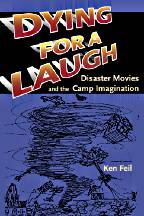Mass Camp
 Not having time lately for tackling books outside my specific area of study, I've resorted to the old intro + 1 approach. My latest read has been Ken Feil's Dying for a Laugh: Disaster Movies and the Camp Imagination (Wesleyan UP, 2005). It's an engaging study of a genre that I don't think has been given full, proper assessment before: the high concept camp film. Feil makes a convincing case that 1980s films like Ghostbusters salvaged the bad object of 1970s disaster films by introducing generic parody and a general ironic stance toward narrative conventions. These set the stage for a full-fledged "mass camp" disaster cylce in the 1990s, typified perhaps by Independence Day or Mars Attacks. As the author sums up his project, "It is one of my arguments that the advent of high concept in the late 1970s leads to the standardization of mass camp. This is not to say that every high concept film becomes campy, but that camp inflections become available, routine aesthetic choices for Hollywood filmmakers." (162)
Not having time lately for tackling books outside my specific area of study, I've resorted to the old intro + 1 approach. My latest read has been Ken Feil's Dying for a Laugh: Disaster Movies and the Camp Imagination (Wesleyan UP, 2005). It's an engaging study of a genre that I don't think has been given full, proper assessment before: the high concept camp film. Feil makes a convincing case that 1980s films like Ghostbusters salvaged the bad object of 1970s disaster films by introducing generic parody and a general ironic stance toward narrative conventions. These set the stage for a full-fledged "mass camp" disaster cylce in the 1990s, typified perhaps by Independence Day or Mars Attacks. As the author sums up his project, "It is one of my arguments that the advent of high concept in the late 1970s leads to the standardization of mass camp. This is not to say that every high concept film becomes campy, but that camp inflections become available, routine aesthetic choices for Hollywood filmmakers." (162)On a gut level, I'm less convinced of his readings of camp, just because the multivalence of classic camp humor seems far more than mere pastiche or parody; what made/makes the disaster film such fodder for gay camp isn't simply that they're cheesy but rather because they allow the viewer to wallow in and resignify pathos (think of the affective identification with Shelley Winters' turn in Poseidon Adventure, doubling the pathos of her character with Winters as has-been actress). That seems to be something missing in the mass camp films and their reception. To his credit, though, Feil distinguishes between queer camp and mass camp, and I wouldn't be surprised to see this book popularize this framework.
The strength of the study is a unity of scope and purpose, uniting textuality, reception and industrial history. Its analysis is strong on reception study - which interests me - though sometimes the author doesn't make clear enough why he is turning to reception; particularly when drifting through every popular critic's evaluation of the films under consideration, the reader deserves a broader framework: is Feil arguing that while academic? Or, conversely is he arguing that popular critics don't understand how these texts work? From the people he quotes, you could read it either way.
So, too, did I want a bit more from the textual and industrial analysis. A section in the Ghostbusters chapter is subtitled, "The Formal Qualities of 1980s Mass Camp," yet surprisingly doesn't deal with cinematic form, dealing with a superficial discussion instead of narrative structure, generic similarities and content. Industrially, the model is clearly Justin Wyatt's work, and Feil provides some consideration of trade press coverage of industrial trends. Might there be more? I know that getting an inside view of studio records may be nigh impossible for films made in the 1990s, but I would like a little more assurance (and this may well be my incomplete reading) that arguments about the industry aren't simply reading backward from the texts themselves. Hopefully I can tackle another chapter or two (say, the one on The Sum of All Fears as a post-9/11 disaster film) to see if my criticism isn't premature.
I don't want to be too harsh, after all. The book is the sort that made me think of a group of contemporary films in a new light, and that's a worthwhile achievement.
UPDATE: Thank to GreenCine for the link. Reading over their post, I realize that my review sniped around the edges. (After all, I'm wrestling with similar methodological issues so am attuned to them.) For any of the book's shortcomings, I still found it to be a thoughtful, engaging reading of a film cycle rarely analyzed, as well as a solid piece of scholarship. I don't think that came across enough.
Comments